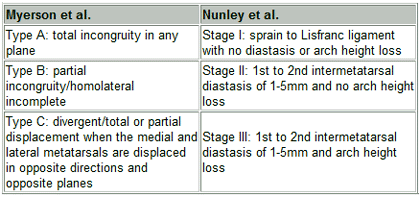|
Conditions & Treatments - Lisfranc Joint Injury |
|
Overview
The tarso-metatarsal joints of the foot are collectively
referred to as the Lisfranc joint. The arch configuration of the
Lisfranc joint in the frontal plane as well as ligamentous
support from the dorsal transverse, plantar transverse, and
intermetatarsal ligaments contribute to the stability of the
joint (2).
|
On x-rays, a widening between
the first and second metatarsals, an avulsion at the base of the second
metatarsal, impaction fractures of the cuboid, medial cuneiform, or
navicular, or flattening of the longitudinal arch may indicate a Lisfranc
joint injury (2).
Treatment
Treatment of Lisfranc joint injuries depends on the severity of the injury.
Most Stage I Lisfranc joint injuries on the Nunley et al. classification
scale are treated conservatively via non-weight-bearing in a cast or cast
boot for 6 weeks (3). Stage II and III Lisfranc joint injuries often require
open reduction internal fixation (3). Surgeons may require eight weeks of
non-weight-bearing followed by four weeks of weight-bearing as tolerated in
a walking boot (3). For optimal outcomes, patients should participate in a
sport-specific physical therapy program (1). Depending on the severity of
the injury, return to sport may take as long as 4 months to a year (3).
Incidence of posttraumatic midtarsal arthritis following Lisfranc joint
injuries is high, with researchers estimating an incidence of 45% (1).
Last revised: November 24, 2014
by Michelle Kornder, DPT
References
1) Bandac R. Modern principles of treatment in lisfranc midfoot
dislocations. Medicina Sportiva : Journal of Romanian Sports Medicine
Society. 2012;8(2):1813-1818. http://search.proquest.com/docview/1038451632?accountid=31077.
2) Mulier T, de Haan J, Vriesendorp P, Reynders P. The treatment of lisfranc
injuries: Review of current literature. European Journal of Trauma and
Emergency Surgery. 2010;36(3):206-216. http://search.proquest.com/docview/578344974?accountid=31077.
doi: http://dx.doi.org/10.1007/s00068-010-1034-5.
3) Reid JJ, Pinney SJ. Midfoot injuries in athletes: Fundamentals of
examination and treatment. Operative Techniques in Sports Medicine.
2010;18(1):46-49. http://search.proquest.com/docview/1035037203?accountid=31077.
doi: http://dx.doi.org/10.1053/j.otsm.2009.11.006.
|
|
|
|

 The term "Lisfranc joint injury" is used to describe a variety
of posttraumatic injuries of the midtarsal region of the foot
(1). 60-70% of Lisfranc joint injuries occur in males with a
mean age of 31 years old (2). Lisfranc injuries are relatively
uncommon, occurring at a rate of 1/55,000 persons per year, and
frequently misdiagnosed (1). Researchers estimate that 20% of
Lisfranc injuries are missed at the initial doctor appointment
(2). (Image displays traumatic Lisfranc fracture with
fractures of the 2nd to 4th distal metatarsals.)
The term "Lisfranc joint injury" is used to describe a variety
of posttraumatic injuries of the midtarsal region of the foot
(1). 60-70% of Lisfranc joint injuries occur in males with a
mean age of 31 years old (2). Lisfranc injuries are relatively
uncommon, occurring at a rate of 1/55,000 persons per year, and
frequently misdiagnosed (1). Researchers estimate that 20% of
Lisfranc injuries are missed at the initial doctor appointment
(2). (Image displays traumatic Lisfranc fracture with
fractures of the 2nd to 4th distal metatarsals.)




